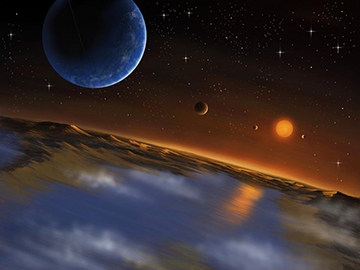Home » Posts tagged with "Exoplanets"
Alien Environment Recreated on Earth
Scientists have determined that chemical hazes and clouds are able to impact surface temperature and a planet’s ability to support life.
A team of scientists at Johns Hopkins University in Baltimore have for the first time managed to recreate the atmosphere of nine exoplanets in a laboratory setting
“I think we are going to learn a lot about [our] Solar System from doing these experiments....
NASA Discovers Three More Potentially Habitable Alien Worlds
The mission has discovered “two new planetary systems that include three super-Earth-size planets in the ‘habitable zone,’ the range of distance from a star where the surface temperature of an orbiting planet might be suitable for liquid water.”
Five planets are in the Kepler-62 system, and two planets are in the Kepler-69 system. Two planets from the Kepler-62 system–62e and 62f–and one...
Tens of Billions of Potentially Habitable Planets in Our Galaxy
A red dwarf star.
Scientists have long assumed that the best chance of finding alien life in the universe is on planets similar to ours. The latest scientific discoveries show that there might be tens of billions of such planets in our galaxy alone.
Astronomers at the European Southern Observatory in Chile came to these findings after studying more than a hundred red dwarves, the most common stars...
NASA discovers 11 new Solar Systems
An artist's impression of the orbital position of planets in systems discovered by NASA's Kepler mission
NASA’s Kepler space telescope has discovered eleven new planetary systems confirming the existence of 26 new planets outside our solar system.
The newly found planets range in size from 1.5 to five times the diameter of Earth and are closer to their host star than Venus is to the Sun.
None...
Planets with Two Suns are Common
An artist's impression of Kepler-34b orbiting a double-star system
Astronomers have discovered two new circumbinary planet systems showing that planets with two suns are common, with probably many millions existing in our Galaxy.
According to the article published in the journal Nature, the two new Saturn-sized planets, Kepler-34b and Kepler-35b, and their systems are located in the constellation...
European astronomers find 16 'super-earths'
European astronomers have claimed to discover at least 16 new so-called “Super-Earths” —planets similar to our own but many times denser— of which one is potentially habitable.
The European Southern Observatory (ESO) said the exoplanets were seen through the High Accuracy Radical velocity Planet Searcher (HARPS) telescope in Chile.
“The harvest of discoveries from HARPS has exceeded...
Darkest planet found: Coal-Black
The newfound gas-giant planet TrES-2b is black with a slight red glow, experts estimate.
Scientists have discovered a Jupiter-size gas giant planet in our galaxy, dubbed Coal-Black planet, as the darkest world in the universe, which reflects almost no light.
Researchers indicate that the inky planet absorbs 99% of the light its star sends its way and reflects only one percent of the light that strikes...
Scientists say there could be 100 million alien Earths in our galaxy
Alan Boyle writes: A leader of the Kepler planet-hunting team has created a slow-moving scientific stir by telling an audience at a high-tech conference that our galaxy could harbor 100 million Earths, based on the space mission’s raw data. The resulting buzz focuses not only on the findings, but also on the means by which they came to light.
The conclusions drawn by Harvard astronomer Dimitar...


















